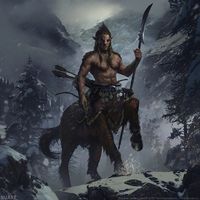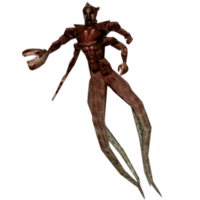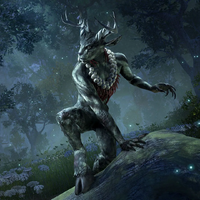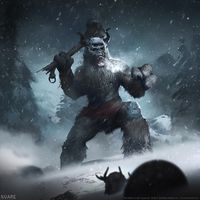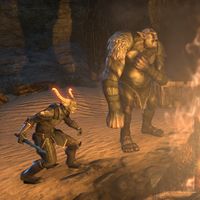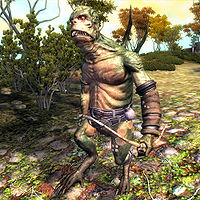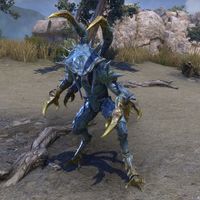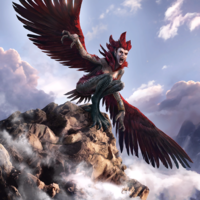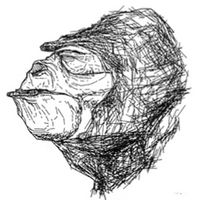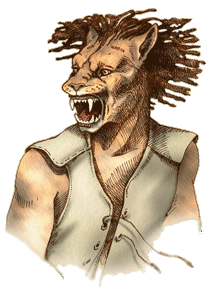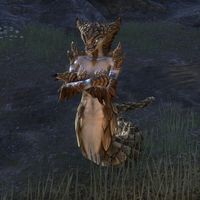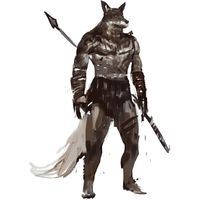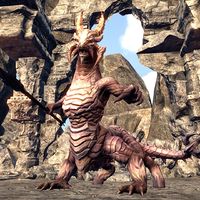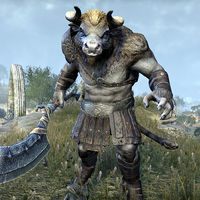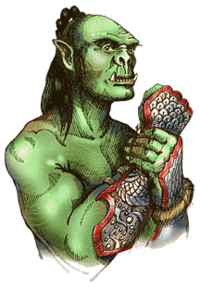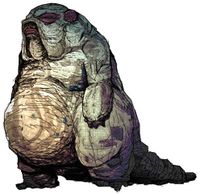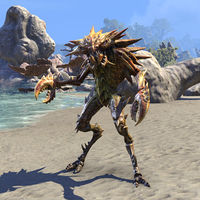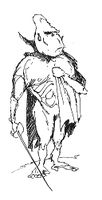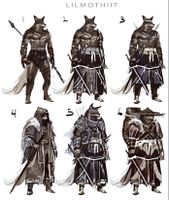Lore:Beastfolk
Beastfolk (also Betmeri, Beastmen,[1] Beast-women,[2] or Betmer)[3] is used to refer to any sentient animal-like humanoid that inhabits Tamriel, such as the Argonians, Imga, and Khajiit. A few races have died out or disappeared, such as the Lilmothiit and the Birdfolk. Though some beastfolk do not have specific animal features, such as the Frost Giants, they are explicitly described as beasts and are therefore included.[4] Additionally, Orcs and Giants are inconsistently described as beastfolk.[1]
The aboriginal beastpeoples lived in preliterate communities throughout Tamriel since at least the early Merethic Era, and each Beast race has its own distinctive accounts of this era before the coming of Elves and Men. Wherever the beastfolk encountered the Elves, the technologically advanced Aldmeri cultures displaced the then-primitive beastfolk into the jungles, marshes, mountains, and wastelands.[1][5] Each Beast race is said to be as culturally and physically distinct from one another as it is from Elven and Manish races.[1]
The term beast-men was popularized by the Reman Empire as propaganda to justify their invasion of the Khajiiti kingdoms by likening the Khajiit to less sentient cats, and the term has stuck ever since.[6]
Contents
Argonians[edit]
Argonians (Saxhleel, or People of the Root in their native language of Jel) are the reptilian natives of Black Marsh, a vast swampland province in southeastern Tamriel. The other races often refer to them as lizards or the Lizard Folk instead, especially when meaning to be derogatory. They are known as the foremost experts in guerrilla warfare throughout Tamriel, a reputation brought upon them by defending their borders from enemies for countless centuries. They have a connection to the Hist, a race of sentient trees.
Agile and cunning, they possess natural immunity to poison and disease, a trait that serves them well in their treacherous homeland. Argonians are swift swimmers and can breathe underwater. They are also naturally adept spellcasters and excel in the art of stealth.
Foreign racial categorization labels them as "beasts", or "Betmeri", as opposed to the humanoid races of Mer and Men. The Argonians' alien nature is often commented on; they are called strange, expressionless, reserved peoples, slow to trust and hard to know. This is a sentiment shared even by lukiul, or "assimilated" Argonians, who were raised far away from the Hist and often have significant trouble fully understanding the emotions, body language, or motivations of their estranged brethren.
While most of Tamriel refers to them as the "Argonians", many Argonians prefer the term "Saxhleel" when referring to their kind; "Argonian" is an Imperial term. Some Argonians opt to take on a more Cyrodiilicized name outside of Black Marsh. Taking on Imperial dress, name, and customs makes things easier for Argonians in Cyrodiil.
According to the First Era Scholar Brendan the Persistent, "The Argonian people have, throughout Tamrielic history, been perhaps the most misunderstood, vilified, and reviled of all the sentient races. Yet, those who have taken the time to experience Argonian culture have gained a greater appreciation for this noble and beautiful people."
For more information, see the main lore article.
Bird Men[edit]
Birdfolk (also known as the Bird Men or Cyrodilic bird-people) were a race of beastfolk who supposedly inhabited what became the City Isle in Cyrodiil during the Early-to-Middle Merethic Era.
Centaur[edit]
Centaurs (sometimes called Horsefolk) are a nomadic, intelligent, and spiritual beast race that possesses the head and torso of a tall powerfully-built man and the lower body of a horse. They are legendary creatures who are worshipped by some and despised by others. Considered to be ancient and mysterious, centaurs are capable of sophisticated speech, have their own language, and refer to others as "mortals", suggesting that they possess a greater lifespan. In Valenwood, centaurs were one of the many civilizations inhabiting the province's vast jungles, predating the elven inhabitants arrival. Following the fall of the Second Empire, they came to inhabit the abandoned human trading posts, and families of centaurs attended revelries in Falinesti alongside Bosmer, Wood Orcs, and Imga. The Elden Hollow beneath Elden Root was the final resting place for generations of centaurs and minotaurs. In High Rock, centaurs made their homes in the woods and hills of Bangkorai, having been more commonly found in the First Era. By the late Third Era, they were still encountered in the Iliac Bay regions of High Rock and Hammerfell.
Dragonling[edit]
Dragonlings (also called Fairy Dragons) are small, intelligent reptilian creatures that are draconic in appearance and native to the Iliac Bay region and Wrothgarian Mountains. Those who speak their language, Dragonish, say that beneath a veneer of maddening riddles and non sequiturs are minds of great wisdom. They are known to be aggressive to those that cannot speak their language. They can breathe fire and pose a fair challenge in combat, it is claimed they are even capable of spellcasting. As such, the Dragonling is considered a worthy opponent for any adventurer. The Knightly Orders of the Iliac Bay region occasionally send their members to slay Dragonlings.
Despite all their merits, Dragonlings are seemingly less grand than their lineage would suggest. In the Third Era, when many were unaware if true Dragons still lived or even existed, the Dragonling's relation to these great Dragons of legends was unknown, with some believing them to be young Dragons or at least kin of true Dragons. Certain scholars considered it common knowledge that Dragons were incapable of reproduction.
By the Fourth Era, scholars came to the conclusion that the Dragonlings of the Iliac Bay region were nothing more than merely "oversized lizards", with no relation to true Dragons. Despite this, some sources still refer to them as Great Wyrms. The relation, if any, of their language to the Dragon Language is unknown.
Dreugh[edit]
The dreugh (/drɛɡ/ listen⏵) are an ancient species of aquatic, octopus-like beastfolk, commonly hunted for their hide and the wax scraped from their shells. They are sometimes known as water dreugh or cepholomer, with a known variant being the dreugh man o'war. The dreugh live on land and in water during different stages of their lives.
Dreugh are known to be immune to paralysis, poison and disease and resistant to magic, but have a low tolerance to frost. They can regenerate health in darkness and in water, but cannot enter holy places. Their infamous shock attacks are unique to land dreugh, and those in the water must rely on melee attacks.
For more information, see the main lore article.
Faun[edit]
Fauns (sometimes called deerfolk) are deerlike trickster beastfolk native to the Systres, where they ecologically fill a similar role that goblins do for most of mainland Tamriel. Rumors exist of creatures of nature either Man or Mer in appearance being the first inhabitants of the archipelago. Fauns themselves are described as having bodies of tall, slender Mer, and are confirmed to have been on the Systres isle of Galen before the Druids of Galen settled there.
Frost Giant[edit]
Frost Giants are a sentient race of huge and sinewy humanoid beasts. They possess four to five eyes, and have two curved horns decorating their forehead. White, shaggy hair covers their bodies. They are extremely strong and have regenerative abilities, provided to them by their "icy" blue blood, which can be stunted by fire. Frost Giants are elusive and rarely seen on Tamriel. They are called "cousins" of common giants, implying some relation. They are very similar in physiology to Frost Trolls.
Goblin-ken[edit]
Goblin-ken (also called goblin-kin or goblinkin) is an unspecific term used to refer to several different beastfolk, including Goblins, Ogres, and Gremlins. Although they have elven blood, Orcs are widely considered to be goblin-ken due to the common belief that they are somehow related to goblins. Goblin-ken have been historically used as slaves by the Altmer of Summerset Isle.
For more information, see the main lore article.
Grummite[edit]
Grummites are violent, primitive humanoids native to the Shivering Isles. They are a species of amphibious frog-like beastfolk with a complex life cycle and incredible regenerative abilities when in water or rain. Like other creatures native to the Isles, Grummites take differing forms depending on whether they inhabit Mania or Dementia.
For more information, see the lore article.
Hadolid[edit]
Hadolids are a race of amphibious, bipedal crablike (or lobsterlike) beastfolk native to the Abecean Sea. Due to traits they share with crustaceans, they have also been referred to as crabfolk. There are two distinct types of Hadolids, those more crablike, with wide flat heads and four claws, and those more lobsterlike, with elongated heads as well as two claws and two hands. They are visually comparable to Dreugh, and their shells are somewhat similar to mudcrabs. Hadolids are migratory, and can stay underwater for a period of a decade or more before returning to land for a similar length of time. Hadolids are capable of diving underwater to depths that surpass even the ability of Argonians, leaving a major part of their lifecycle a mystery to researchers. Their odor is reminiscent of rotting meat. They travel in hunting packs and are capable of using powerful magic and weapons. They are commonly seen venturing onto land on the Systres.
For more information, see the main lore article.
Harpy[edit]
Harpies are a race of fierce, carnivorous, feminine humanoid beast-women with the wings of a bird. They are common nuisance around the Iliac Bay area, particularly in Lainlyn, but are found wherever there are rocky cliffs and crags suitable for their nests. They also build their nests in abandoned ruins. While their maniacal nature makes them somewhat less-than-brilliant tacticians, their sharp talons and frenzied behavior often force kingdoms to abandon lands to their use. Mercenary groups like the Fighters Guild are sometimes hired to clear out harpy nests for groups that pass through their territory, such as traveling merchants. Harpy feathers are very valuable, prized by tailors and quill merchants alike. Harpy down can be spun with fine sheep's wool to make a sturdy material for mages' robes. Harpies tend to smell foul.
Hob[edit]
Hobs are a race of hairless monkey-like creatures of unclear origin, who inhabited the floating island Umbriel. They have long arms and legs, and very long, thin, delicate fingers. Their faces are described as goblinesque, with huge toothless mouths and large green eyes.
Hobs can speak very simple Tamrielic, though they seem to have their own language as well. They were used as assistants by chefs in the kitchens of Umbriel, and were usually tasked with fetching specific ingredients. Troops of them could sometimes be found harvesting bloodball fruit in the Marrow Sump. Supposedly, some chefs would train their Hobs to perform "unconventional" favors for them.
Imga[edit]
The Imga, also called Great Apes or Apemen, are native beastfolk of Valenwood. These intelligent apes are said to have flourished in Valenwood long before the Aldmer ever arrived there. They cohabit in the forests with the Bosmer tribes, and also inhabit many of the abandoned human trading posts which had been established during the Second Empire. The apemen are also reportedly found in the mountainous areas in the west and north of Tamriel, and seldom encountered in the East. The Dunmer kept the apemen as slaves, though not in as great numbers as they keep Argonians.
The most notable Imga was undoubtedly Marukh, a First Era prophet who rose to prominence during the Camoran Dynasty. His teachings sparked the massive cultural and spiritual movement known as the Alessian Order. Other Imga would go on to follow his teachings in the Marukhati Selective.
Khajiit[edit]
Khajiit (listen ⏵, from Ta'agra, meaning desert-dweller) are cat-like people who come from Elsweyr, known for high intelligence and agility. These traits make them very good thieves and acrobats, but Khajiit are also fearsome warriors. They are rarely known to be mages. Khajiit mostly stay on land, but piracy and Skooma trade does draw some to work as sailors.
Khajiit anatomy differs greatly from both men and mer, not only because of their fur, tail, and sometimes toe-walking stance, but also their digestive system and metabolism. Khajiit, Argonians, and Imga are the so-called "beast races" of Tamriel because of these large differences. Khajiit have a lifespan similar to that of humans. There are no well-documented cases of cross-breeding between Khajiit and other races, though there are rumors of such a thing. The foreign appearance and behavior of Khajiit make them common targets of racial discrimination, being given the name Cat-Men by foreigners, which the Khajiit don't take lightly.
For more information, see the main lore article.
Lamia[edit]
Lamias (or Lamiae) are a species of amphibious reptilian beastfolk. They have a serpentine appearance, with the torso of a woman and the tail of a snake. Despite appearing to be exclusively female, it is assumed they are hermaphroditic or sexless. They are incredibly protective of their eggs, though it has been claimed they later abandon them and leave the immature Lamiae to fend for themselves. Found in various parts of Tamriel, they can live in water or on land, although they rarely venture far from the water, and are known to take up residence in abandoned ruins. Some desert Lamias also reside in Hammerfell. Lamias are larger than most other mortal races, and according to one unconfirmed fable, are capable of interbreeding with them. They appear to be cold-blooded and are known to lounge in the sun.
Lilmothiit[edit]
The Lilmothiit (possibly meaning "one who is from Lilmoth"), also called the Fox-Folk, are a vulpine (fox-like) beast race who once inhabited Black Marsh. Some scholars speculate that the Lilmothiit are related to the Khajiit of Elsweyr. The Lilmothiit were a nomadic tribal group, and left few enduring signs of their existence. A tribe of Lilmothiit were contemporary with an ancient Faun tribe present on mainland Tamriel. In response to Elven invaders, the Lilmothiit chose to hide with their young kits rather than fight as the Fauns did.
They founded the settlements of Lilmoth and Blackrose, and the southern coastal regions of the province were considered to be their realm. Lilmoth later came to be occupied by merchants and neighboring Argonian tribes. Some of the Lilmothiit ruins of Blackrose were later turned into Blackrose prison in a single day by Pelladil Direnni, who summoned an army of stone atronachs at the request of Potentate Versidue-Shaie in the Second Era.
For many generations, the Lilmothiit were in decline, and they eventually withdrew their presence on the coasts to the inland regions around Blackrose. In the Second Era, the Lilmothiit were scarcely seen. Several scholars from High Rock believed the ones in Lilmoth had succumbed to the Knahaten Flu, leaving behind many ruins for archeologists to scour. As of 2E 582, in the region of Blackwood, a kind of sleek paper kite, painted bright orange and featuring a real fox's tail was a common toy. It was named Lilmothiit Fox-Kite, after the vulpine folk.
For more information, see the main lore article.
Lizard Bull[edit]
The Lizard Bulls are a mysterious race of beasts indigenous to the islands along the coast of Pyandonea. They were accidentally discovered during the Interregnum on an ill-fated expedition to Pyandonea by a crew of pirates, who were led by the infamous Captain Wereshark. Due to both the immediate hostility between the two parties and their sheer remoteness from Tamriel, little is known about them beyond what was documented during this expedition.
Captain Wereshark's first mate described them as massive quadrupedal monstrosities, wielding "glittering trident(s) shiny as one you'd see carried by some stuffy Altmer Queensguard". The first mate theorized that they may have killed the inhabitants of the island who lived within the stick huts scattered throughout, though whether any other race ever truly lived there was left unclear.
Lizard Bulls are extremely durable and skilled at combat, with just eight of them of defeating an entire Maormeri armada. Their level of intelligence is unfortunately unknown, as Wereshark's crew never had a chance to speak to them prior to their mage assaulting one with a fireball to the face.
Mantikora[edit]
Mantikoras are unnatural composite creatures, artificially created to serve as soldiers by the Scaled Court circa 2E 572. They were created via their experiments with nirncrux, alchemy, and ritualistic magics. They combine the traits of numerous predators, such as crocodiles, welwas, scorpions, and specially bred wamasu. Additionally, captured Men and Mer were also utilized to give the creatures their sapience. Mantikoras were created to be used in the Serpent's plot to revert Tamriel back to the chaos of the Dawn Era. One was even possessed by him to battle his enemies.
Mantikoras are large, powerful, and exceptionally intelligent - and that makes them extremely dangerous. They are intelligent enough to communicate and barter with other races. They are aggressive creatures that like the thrill of the hunt, and they never kill their victim quickly to enjoy their fun. They typically wield huge javelins in combat, though they are also capable of producing a deadly venom. Their venom can cook their victims from the inside, leaving them as venom-charred husks. The venom of a specific Mantikora, Tapupezu Azzida, was used as a supplement in an illegal narcotic known as Daze in Fargrave. While Daedra could survive it, it is lethal to mortals, though regular Mantikora venom is devasting even to Daedra.
Only certain Mantikoras, known as progenitors, are created with the ability to breed.
Minotaur[edit]
Minotaurs, also called man-bulls or bull-men, are a species of beastfolk native to Cyrodiil with the body of a man and the head of a bull. During the First Era, they were said to have symbolized the Alessian Empire, but in later eras became more commonly perceived as savage monsters by the people of Tamriel.
They have thick grey or sometimes brown or red hide and fur, and large curved horns. Some Minotaurs clothe themselves in a simple loincloth and shawl or wear nose-rings. Others wear intricate leather armor, and some prefer to be completely naked. They are most commonly found in the Blackwood, Colovian Highlands, Great Forest and the Gold Coast regions of Cyrodiil, as well as The Scar of Elsweyr, the Reach, and in ancient times across Bangkorai and Valenwood.
For more information, see the main lore article.
Orc[edit]
Orcs, also called Orsimer (Aldmeris: Cursed or Pariah Folk) in ancient times (as well as in modern times by followers of Trinimac), and Ornim in their native tongue, are the people of the Wrothgarian Mountains, Dragontail Mountains, Valenwood, Skyrim, northern Morrowind, and Orsinium (literally translated as "Orc-Town"). They are noted for their unshakable courage in war and their unflinching endurance of hardships. Orcs have elven blood, but are sometimes grouped into Beastfolk, specifically Goblin-ken.
In the past, Orcs were widely feared and hated by the other nations and races of Tamriel and were seen as nothing more than uncivilized beasts, savage barbarians. The Orcs are as civilized as any of the other races, having worked hard to be seen as actual people.[nb 1] They have slowly won acceptance in the Empire, in particular for their distinguished service in the Emperor's Legions. Many Orcs in the Third Era have actually received an Imperial education as a benefit of serving the Imperial Legion. Orc armorers are prized for their craftsmanship, and Orc warriors in heavy armor are among the finest front-line troops in the Empire, and are fearsome when using their berserker rage.
Orcs have a lifespan similar to that of humans, possibly because according to the Nords, Shor passed a curse Orkey had placed on the Nords onto the Orcs. Orc's blood has alchemical properties, and is also known as the "Rising Sun". While many Imperial citizens regard Orc society as rough and cruel, the Orcs consider themselves to be stern, fair, and just. Orcs have their own language known as Orcish.
For more information, see the main lore article.
Sload[edit]
The Sload (sometimes called Slugmen, slug-folk, slug people, grubs, or worms) are a race of slug-like (sometimes described as toad-like) beastfolk native to the Coral Kingdoms of Thras, southwest of Tamriel. They are semi-aquatic, corpulent beings, known to grow to massive sizes. Their culture is largely based on necromancy.
They are described by the Khajiit explorer Ja'dasha as among the most horrible and dangerous creatures of the sea, along with krakens and sea serpents. They are particularly infamous for releasing the Thrassian Plague upon Tamriel in 1E 2260, killing more than half of the population. They are highly intelligent and skilled at magic, and their mastery of necromancy is renowned. They supposedly only practice Necromancy on other races, which some say explains the number of slaves they purchase in Tear, and the rumors of Sload airships carrying corpses from Senchal. Said airships are known as Sload floaters, which are living gasbags, used for mass transit and warfare.
Sload are innately cautious and careful, and in their mythic traditions their heroes spend years planning, considering and consulting with wise Sload before taking the correct action and achieving their goal. By contrast, their villains all act quickly or rashly and always fail. The Sload language has no word for 'adventure', and the closest equivalent more accurately means 'tragic disaster'.
Sload do not seem to experience emotions as the Tamrielic races do, but are often skilled at acting and may exaggeratedly simulate them for the benefit of more emotive beings. They will honor laws, loyalties, and friendships only as long as they calculate it to be in their best interests to do so. They also have no compunctions against blasphemy, theft, kidnapping, murder, genocide or anything else that may help them reach their goals.
Sload are apparently not religious and generally reject worship, but will willingly serve Daedra if they benefit from it. Some, in particular the famed Second Era necromancer N'Gasta, also follow the King of Worms. Despite their general rejection of worship, some accounts describe the Sload engaging in elaborate sacrificial rituals which involve individuals with years of preparation re-enacting the deeds of mythical heroes and villains, before sacrificing themselves via the application of "dessication crystals" to their bodies. Such rituals have been theorized to be a form of worship directed towards the Sload ancestors, or towards unnamed deities of theirs.
Yaghra[edit]
Yaghra are a race of deep-sea creatures, said to have been created from crustacean-like bottom feeders, that serve the Sea Sload. They live in Nirn's many seas and oceans, and are only rarely seen on land. They are said to be followers of an unspoken social hierarchy. The Sea Sload address their yaghra servants through a combination of the guttural Sload language and mind magic. They are even capable of being taught magic themselves by their masters.
Yaghra are fear-inducing to the point that they are alleged to make Dreugh "seem like purring kittens" by comparison. Their strange appearance often garners comparisons to Daedra, though they are unrelated.
Notes[edit]
- Early documented encounters between the Akaviri and the earliest inhabitants of Tamriel suggest that there may be Akaviri people with rat-like features, and others who are canine in appearance.[7]
Gallery[edit]
References[edit]
- ^ a b c d Betmeri topic in Morrowind
- ^ The Assassin of Alik'r — Anonymous
- ^ Captain Tendil's dialogue during Lifting the Veil in ESO
- ^ The Elder Scrolls V: Skyrim: Prima Official Game Guide — David Hodgson
- ^ Before the Ages of Man — Aicantar of Shimerene
- ^ Moon Bishop Hunal Answers Your Questions — Moon Bishop Hunal
- ^ Pocket Guide to the Empire, 3rd Edition: Other Lands — Imperial Geographical Society, 3E 432
|
|||||||||||||||||||||||||||||||||||||||||||

